Case Study: PDSA Cycle for Procurement and Supply Chain Improvement
VerifiedAdded on 2022/12/29
|16
|4215
|41
Case Study
AI Summary
This case study examines the application of the Plan-Do-Study-Act (PDSA) cycle for improving procurement and supply chain processes within Woolworths, a major Australian supermarket chain. The study begins with an introduction to the PDSA cycle and its importance in continuous improvement, particularly in addressing customer complaints regarding home appliances. The methodology involves the use of tools such as the 5 Whys, check sheets, Pareto analysis, and project charters to identify and address root causes of product quality issues. The case study details two PDSA cycles, the first focusing on improving raw material quality and the second on addressing product performance discrepancies. The analysis includes data collection, problem identification, solution implementation, and results evaluation, demonstrating how the PDSA cycle can lead to significant improvements in product quality, customer satisfaction, and overall business performance. The case study highlights the iterative nature of the PDSA cycle and the importance of continuous monitoring and adjustment to achieve sustained improvements in procurement and supply chain management.

Improvement in Procuremnt and Supply Chain
Paraphrase This Document
Need a fresh take? Get an instant paraphrase of this document with our AI Paraphraser
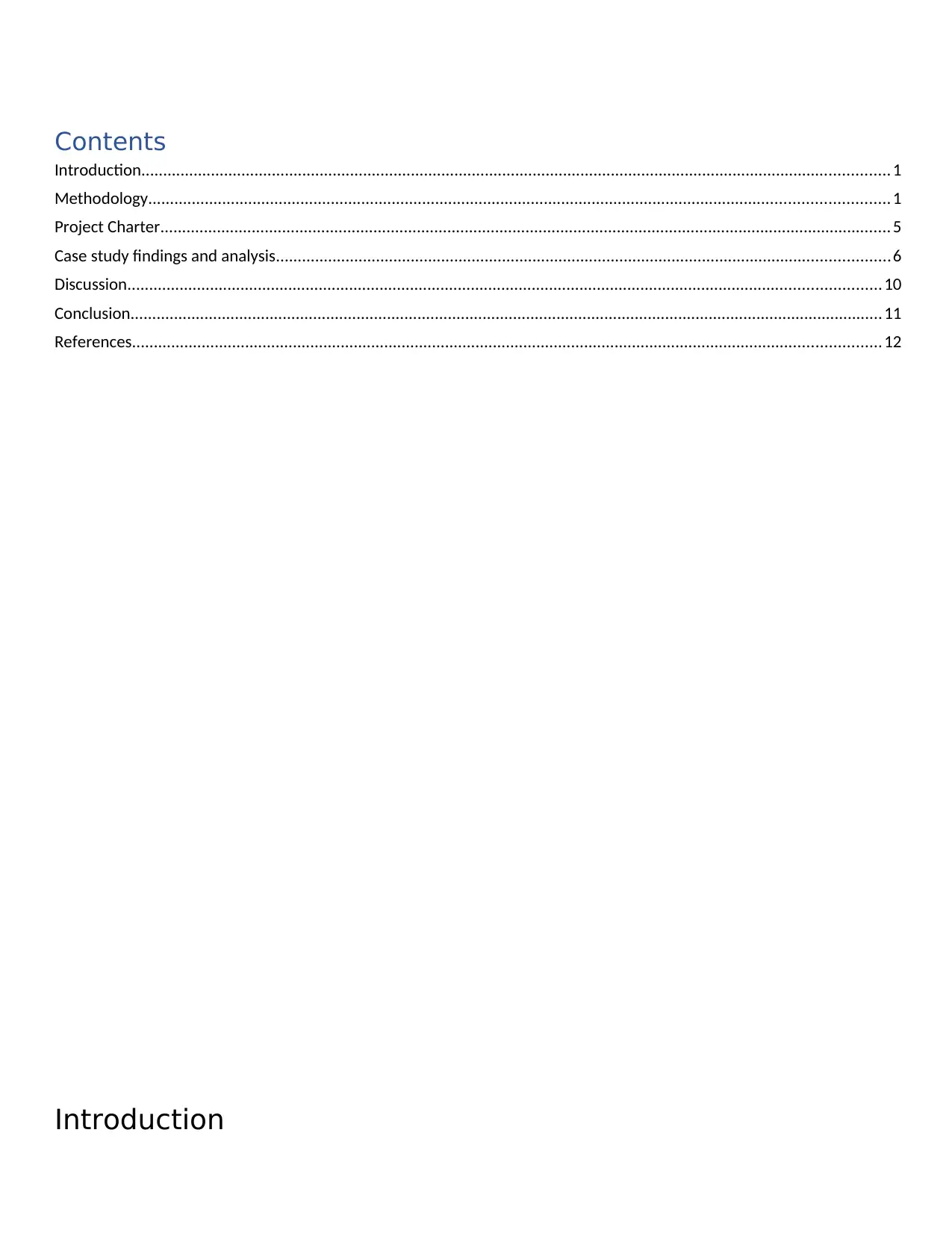
Contents
Introduction............................................................................................................................................................................ 1
Methodology.......................................................................................................................................................................... 1
Project Charter........................................................................................................................................................................ 5
Case study findings and analysis.............................................................................................................................................6
Discussion............................................................................................................................................................................. 10
Conclusion............................................................................................................................................................................. 11
References............................................................................................................................................................................ 12
Introduction
Introduction............................................................................................................................................................................ 1
Methodology.......................................................................................................................................................................... 1
Project Charter........................................................................................................................................................................ 5
Case study findings and analysis.............................................................................................................................................6
Discussion............................................................................................................................................................................. 10
Conclusion............................................................................................................................................................................. 11
References............................................................................................................................................................................ 12
Introduction

The concept of PDSA or Plan Do Study Act is an important tool which is related to concept of continuous
improvement which helps in identification of any issues that affects customers. The current report focuses
on the application of the PDSA tool in context of Woolworths, which is experiencing various complaints
from their customers of home appliances product as it affects their safety and health.
Case organization
Woolworths is one of the largest supermarket chains of Australia, recently there has been increasing
number of complaints from multiple customers who have either purchased in-house deep fryer product,
drain cleaner, safety matches, in-house padded flop chair. These have caused safety concerns and have
resulted in increasing dissatisfaction among customers leading to negative reputation of the company.
Methodology
The methodology that will be used for implementing changes in the above case organization is PDSA.
PDCA cycle focuses on identification of changes for improvement and after the changes are being
implemented various other ways should be predicted for making advanced improvements. The steps
which are involved in PDSA cycle are as follows:
Plan: The opportunity for change and identified and accordingly the change is planned
Do: The changes which are being identified are implemented on a small scale.
Check: Analysis should be undertaken based on the collected data and evaluation should be made in
order to determine whether the variation is positive or not.
Act: The changes will be implemented on a large scale if the change which was implemented in small
case was successful in nature and the results of the changes will be analyzed on a continuous basis. If the
product improvement fails in a single cycle, then a new cycle of improvement should be implemented.
5 Whys
As stated by Samuel, Marathamuthu and Murugaiah (2015) in order to understand the areas of problem,
improvement which helps in identification of any issues that affects customers. The current report focuses
on the application of the PDSA tool in context of Woolworths, which is experiencing various complaints
from their customers of home appliances product as it affects their safety and health.
Case organization
Woolworths is one of the largest supermarket chains of Australia, recently there has been increasing
number of complaints from multiple customers who have either purchased in-house deep fryer product,
drain cleaner, safety matches, in-house padded flop chair. These have caused safety concerns and have
resulted in increasing dissatisfaction among customers leading to negative reputation of the company.
Methodology
The methodology that will be used for implementing changes in the above case organization is PDSA.
PDCA cycle focuses on identification of changes for improvement and after the changes are being
implemented various other ways should be predicted for making advanced improvements. The steps
which are involved in PDSA cycle are as follows:
Plan: The opportunity for change and identified and accordingly the change is planned
Do: The changes which are being identified are implemented on a small scale.
Check: Analysis should be undertaken based on the collected data and evaluation should be made in
order to determine whether the variation is positive or not.
Act: The changes will be implemented on a large scale if the change which was implemented in small
case was successful in nature and the results of the changes will be analyzed on a continuous basis. If the
product improvement fails in a single cycle, then a new cycle of improvement should be implemented.
5 Whys
As stated by Samuel, Marathamuthu and Murugaiah (2015) in order to understand the areas of problem,
⊘ This is a preview!⊘
Do you want full access?
Subscribe today to unlock all pages.

Trusted by 1+ million students worldwide
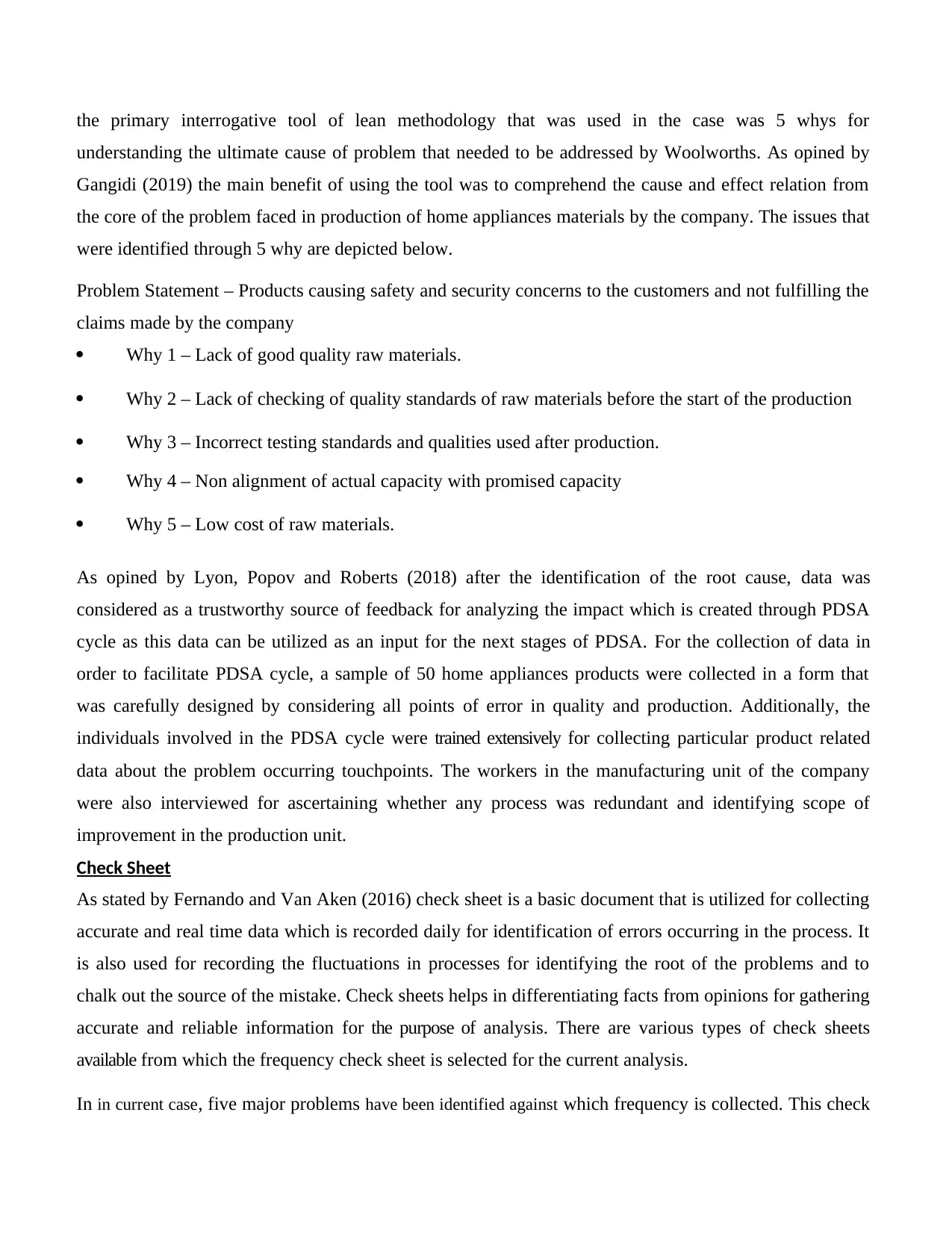
the primary interrogative tool of lean methodology that was used in the case was 5 whys for
understanding the ultimate cause of problem that needed to be addressed by Woolworths. As opined by
Gangidi (2019) the main benefit of using the tool was to comprehend the cause and effect relation from
the core of the problem faced in production of home appliances materials by the company. The issues that
were identified through 5 why are depicted below.
Problem Statement – Products causing safety and security concerns to the customers and not fulfilling the
claims made by the company
Why 1 – Lack of good quality raw materials.
Why 2 – Lack of checking of quality standards of raw materials before the start of the production
Why 3 – Incorrect testing standards and qualities used after production.
Why 4 – Non alignment of actual capacity with promised capacity
Why 5 – Low cost of raw materials.
As opined by Lyon, Popov and Roberts (2018) after the identification of the root cause, data was
considered as a trustworthy source of feedback for analyzing the impact which is created through PDSA
cycle as this data can be utilized as an input for the next stages of PDSA. For the collection of data in
order to facilitate PDSA cycle, a sample of 50 home appliances products were collected in a form that
was carefully designed by considering all points of error in quality and production. Additionally, the
individuals involved in the PDSA cycle were trained extensively for collecting particular product related
data about the problem occurring touchpoints. The workers in the manufacturing unit of the company
were also interviewed for ascertaining whether any process was redundant and identifying scope of
improvement in the production unit.
Check Sheet
As stated by Fernando and Van Aken (2016) check sheet is a basic document that is utilized for collecting
accurate and real time data which is recorded daily for identification of errors occurring in the process. It
is also used for recording the fluctuations in processes for identifying the root of the problems and to
chalk out the source of the mistake. Check sheets helps in differentiating facts from opinions for gathering
accurate and reliable information for the purpose of analysis. There are various types of check sheets
available from which the frequency check sheet is selected for the current analysis.
In in current case, five major problems have been identified against which frequency is collected. This check
understanding the ultimate cause of problem that needed to be addressed by Woolworths. As opined by
Gangidi (2019) the main benefit of using the tool was to comprehend the cause and effect relation from
the core of the problem faced in production of home appliances materials by the company. The issues that
were identified through 5 why are depicted below.
Problem Statement – Products causing safety and security concerns to the customers and not fulfilling the
claims made by the company
Why 1 – Lack of good quality raw materials.
Why 2 – Lack of checking of quality standards of raw materials before the start of the production
Why 3 – Incorrect testing standards and qualities used after production.
Why 4 – Non alignment of actual capacity with promised capacity
Why 5 – Low cost of raw materials.
As opined by Lyon, Popov and Roberts (2018) after the identification of the root cause, data was
considered as a trustworthy source of feedback for analyzing the impact which is created through PDSA
cycle as this data can be utilized as an input for the next stages of PDSA. For the collection of data in
order to facilitate PDSA cycle, a sample of 50 home appliances products were collected in a form that
was carefully designed by considering all points of error in quality and production. Additionally, the
individuals involved in the PDSA cycle were trained extensively for collecting particular product related
data about the problem occurring touchpoints. The workers in the manufacturing unit of the company
were also interviewed for ascertaining whether any process was redundant and identifying scope of
improvement in the production unit.
Check Sheet
As stated by Fernando and Van Aken (2016) check sheet is a basic document that is utilized for collecting
accurate and real time data which is recorded daily for identification of errors occurring in the process. It
is also used for recording the fluctuations in processes for identifying the root of the problems and to
chalk out the source of the mistake. Check sheets helps in differentiating facts from opinions for gathering
accurate and reliable information for the purpose of analysis. There are various types of check sheets
available from which the frequency check sheet is selected for the current analysis.
In in current case, five major problems have been identified against which frequency is collected. This check
Paraphrase This Document
Need a fresh take? Get an instant paraphrase of this document with our AI Paraphraser

sheet is later utilized as a basis for Pareto analysis. It helps in providing raw data and general information for
identification of the issues which needs to be addressed before the phase of planning and implementing.
Probl
em
Frequency
T
ot
al
Mo
nda
y
Tue
sda
y
Wedn
esday
Thur
sday
Fri
da
y
Satu
rday
Su
nda
y
Poor
quali
ty of
raw
mate
rials
3 2 3 2 3 5 6 2
4
High
level
of
varia
tions
betw
een
the
claim
ed
benef
its
and
the
actua
l
benef
its.
3 3 2 4 3 3 2 2
3
Lack 3 2 3 3 2 2 3 1
identification of the issues which needs to be addressed before the phase of planning and implementing.
Probl
em
Frequency
T
ot
al
Mo
nda
y
Tue
sda
y
Wedn
esday
Thur
sday
Fri
da
y
Satu
rday
Su
nda
y
Poor
quali
ty of
raw
mate
rials
3 2 3 2 3 5 6 2
4
High
level
of
varia
tions
betw
een
the
claim
ed
benef
its
and
the
actua
l
benef
its.
3 3 2 4 3 3 2 2
3
Lack 3 2 3 3 2 2 3 1
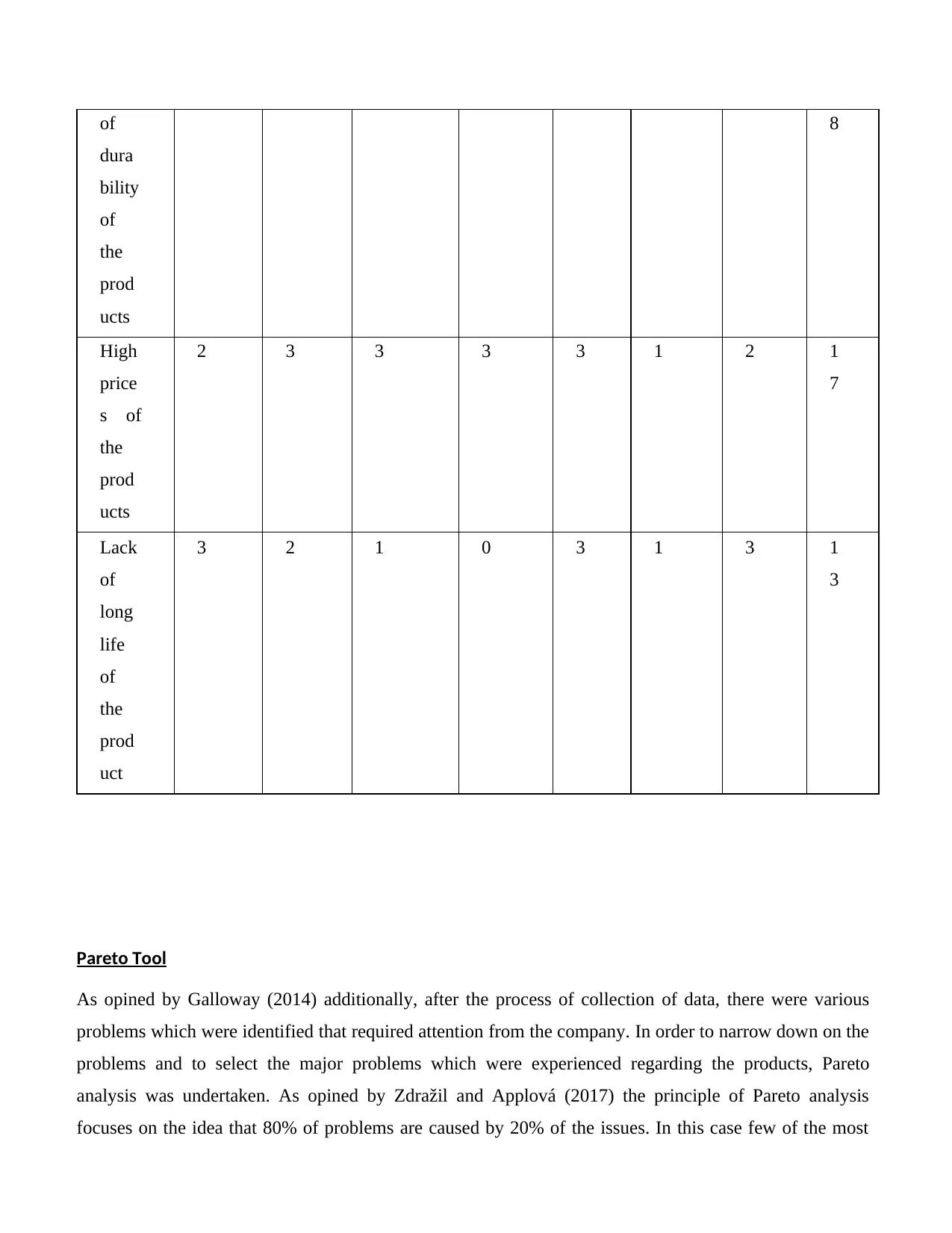
of
dura
bility
of
the
prod
ucts
8
High
price
s of
the
prod
ucts
2 3 3 3 3 1 2 1
7
Lack
of
long
life
of
the
prod
uct
3 2 1 0 3 1 3 1
3
Pareto Tool
As opined by Galloway (2014) additionally, after the process of collection of data, there were various
problems which were identified that required attention from the company. In order to narrow down on the
problems and to select the major problems which were experienced regarding the products, Pareto
analysis was undertaken. As opined by Zdražil and Applová (2017) the principle of Pareto analysis
focuses on the idea that 80% of problems are caused by 20% of the issues. In this case few of the most
dura
bility
of
the
prod
ucts
8
High
price
s of
the
prod
ucts
2 3 3 3 3 1 2 1
7
Lack
of
long
life
of
the
prod
uct
3 2 1 0 3 1 3 1
3
Pareto Tool
As opined by Galloway (2014) additionally, after the process of collection of data, there were various
problems which were identified that required attention from the company. In order to narrow down on the
problems and to select the major problems which were experienced regarding the products, Pareto
analysis was undertaken. As opined by Zdražil and Applová (2017) the principle of Pareto analysis
focuses on the idea that 80% of problems are caused by 20% of the issues. In this case few of the most
⊘ This is a preview!⊘
Do you want full access?
Subscribe today to unlock all pages.

Trusted by 1+ million students worldwide
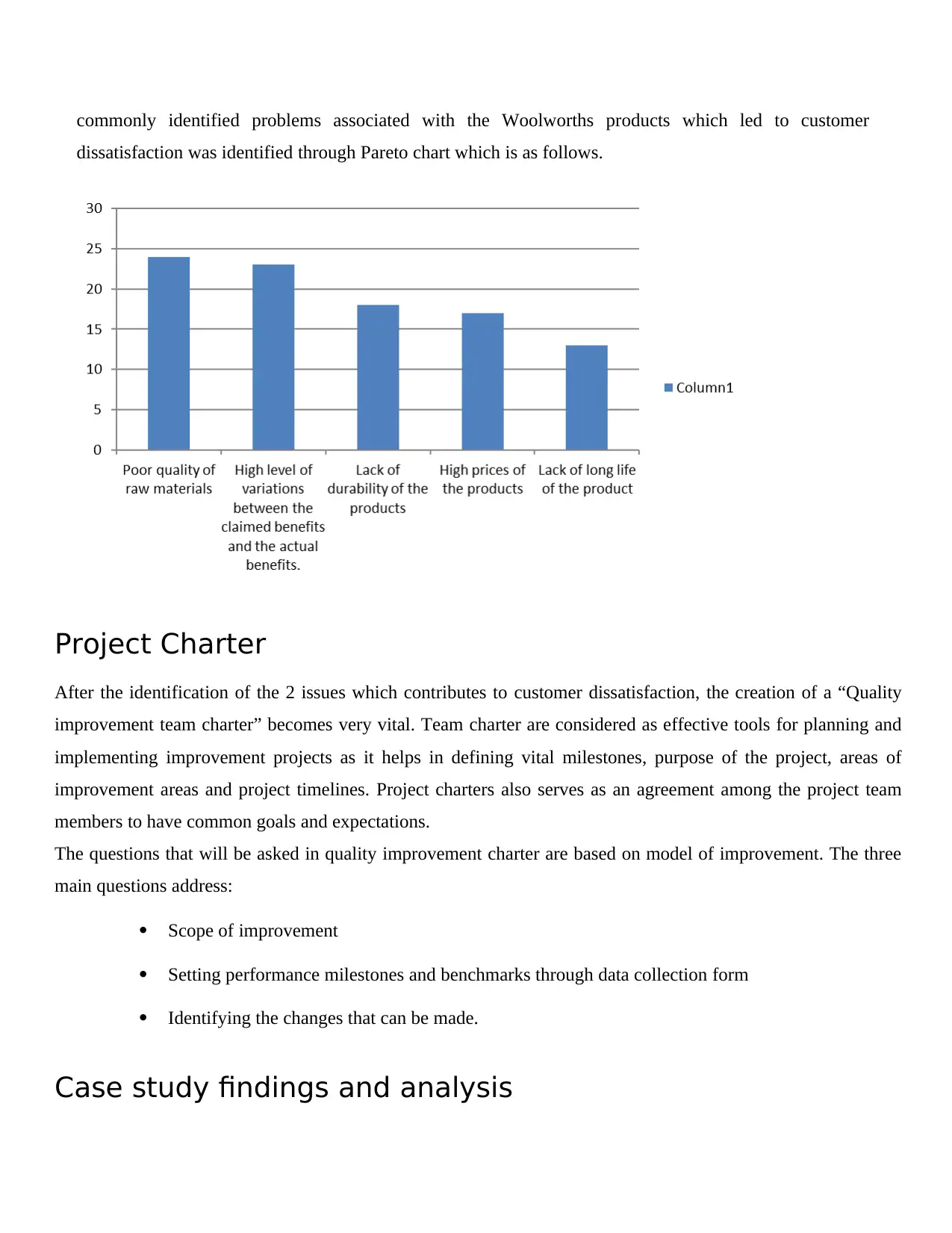
commonly identified problems associated with the Woolworths products which led to customer
dissatisfaction was identified through Pareto chart which is as follows.
Project Charter
After the identification of the 2 issues which contributes to customer dissatisfaction, the creation of a “Quality
improvement team charter” becomes very vital. Team charter are considered as effective tools for planning and
implementing improvement projects as it helps in defining vital milestones, purpose of the project, areas of
improvement areas and project timelines. Project charters also serves as an agreement among the project team
members to have common goals and expectations.
The questions that will be asked in quality improvement charter are based on model of improvement. The three
main questions address:
Scope of improvement
Setting performance milestones and benchmarks through data collection form
Identifying the changes that can be made.
Case study findings and analysis
dissatisfaction was identified through Pareto chart which is as follows.
Project Charter
After the identification of the 2 issues which contributes to customer dissatisfaction, the creation of a “Quality
improvement team charter” becomes very vital. Team charter are considered as effective tools for planning and
implementing improvement projects as it helps in defining vital milestones, purpose of the project, areas of
improvement areas and project timelines. Project charters also serves as an agreement among the project team
members to have common goals and expectations.
The questions that will be asked in quality improvement charter are based on model of improvement. The three
main questions address:
Scope of improvement
Setting performance milestones and benchmarks through data collection form
Identifying the changes that can be made.
Case study findings and analysis
Paraphrase This Document
Need a fresh take? Get an instant paraphrase of this document with our AI Paraphraser
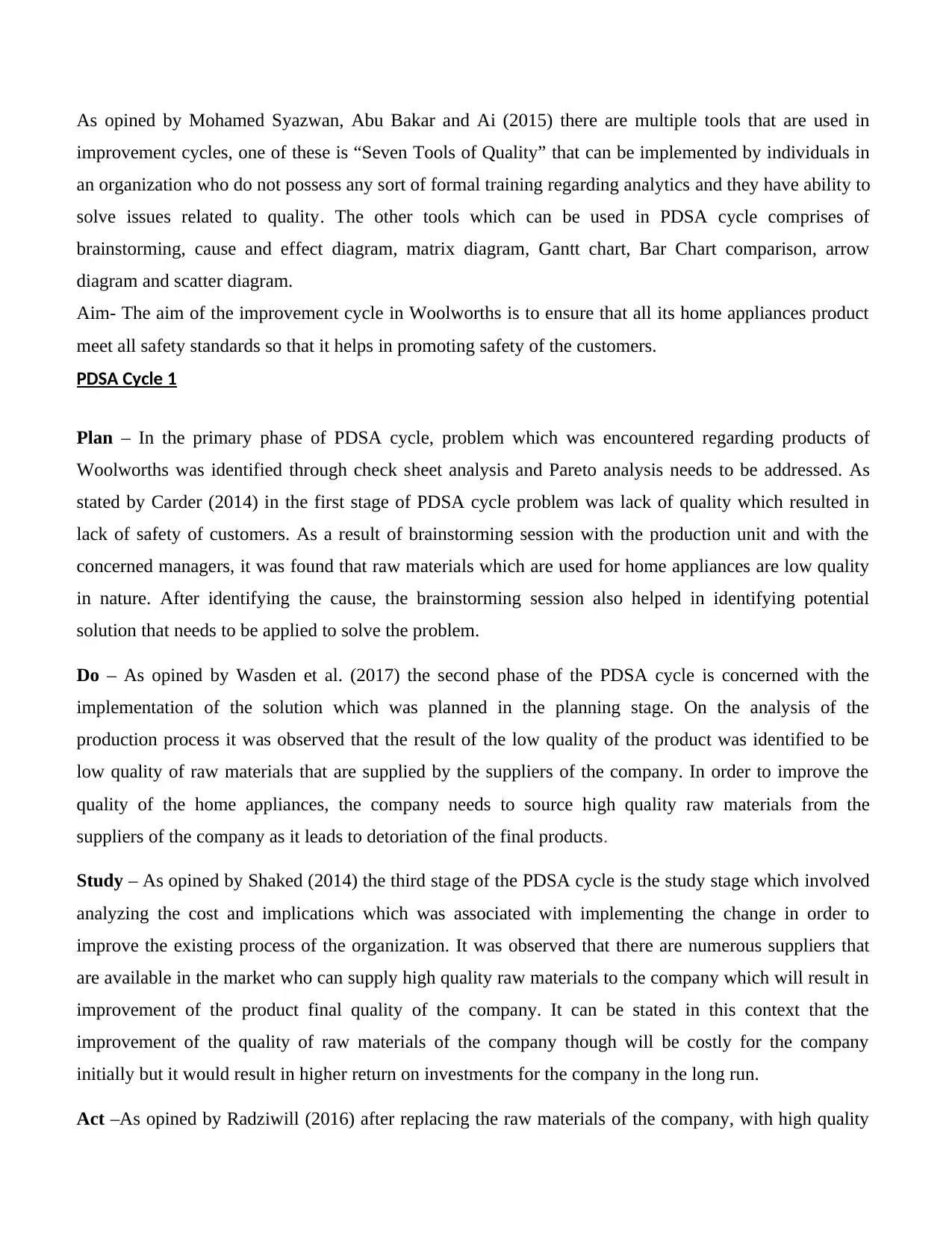
As opined by Mohamed Syazwan, Abu Bakar and Ai (2015) there are multiple tools that are used in
improvement cycles, one of these is “Seven Tools of Quality” that can be implemented by individuals in
an organization who do not possess any sort of formal training regarding analytics and they have ability to
solve issues related to quality. The other tools which can be used in PDSA cycle comprises of
brainstorming, cause and effect diagram, matrix diagram, Gantt chart, Bar Chart comparison, arrow
diagram and scatter diagram.
Aim- The aim of the improvement cycle in Woolworths is to ensure that all its home appliances product
meet all safety standards so that it helps in promoting safety of the customers.
PDSA Cycle 1
Plan – In the primary phase of PDSA cycle, problem which was encountered regarding products of
Woolworths was identified through check sheet analysis and Pareto analysis needs to be addressed. As
stated by Carder (2014) in the first stage of PDSA cycle problem was lack of quality which resulted in
lack of safety of customers. As a result of brainstorming session with the production unit and with the
concerned managers, it was found that raw materials which are used for home appliances are low quality
in nature. After identifying the cause, the brainstorming session also helped in identifying potential
solution that needs to be applied to solve the problem.
Do – As opined by Wasden et al. (2017) the second phase of the PDSA cycle is concerned with the
implementation of the solution which was planned in the planning stage. On the analysis of the
production process it was observed that the result of the low quality of the product was identified to be
low quality of raw materials that are supplied by the suppliers of the company. In order to improve the
quality of the home appliances, the company needs to source high quality raw materials from the
suppliers of the company as it leads to detoriation of the final products.
Study – As opined by Shaked (2014) the third stage of the PDSA cycle is the study stage which involved
analyzing the cost and implications which was associated with implementing the change in order to
improve the existing process of the organization. It was observed that there are numerous suppliers that
are available in the market who can supply high quality raw materials to the company which will result in
improvement of the product final quality of the company. It can be stated in this context that the
improvement of the quality of raw materials of the company though will be costly for the company
initially but it would result in higher return on investments for the company in the long run.
Act –As opined by Radziwill (2016) after replacing the raw materials of the company, with high quality
improvement cycles, one of these is “Seven Tools of Quality” that can be implemented by individuals in
an organization who do not possess any sort of formal training regarding analytics and they have ability to
solve issues related to quality. The other tools which can be used in PDSA cycle comprises of
brainstorming, cause and effect diagram, matrix diagram, Gantt chart, Bar Chart comparison, arrow
diagram and scatter diagram.
Aim- The aim of the improvement cycle in Woolworths is to ensure that all its home appliances product
meet all safety standards so that it helps in promoting safety of the customers.
PDSA Cycle 1
Plan – In the primary phase of PDSA cycle, problem which was encountered regarding products of
Woolworths was identified through check sheet analysis and Pareto analysis needs to be addressed. As
stated by Carder (2014) in the first stage of PDSA cycle problem was lack of quality which resulted in
lack of safety of customers. As a result of brainstorming session with the production unit and with the
concerned managers, it was found that raw materials which are used for home appliances are low quality
in nature. After identifying the cause, the brainstorming session also helped in identifying potential
solution that needs to be applied to solve the problem.
Do – As opined by Wasden et al. (2017) the second phase of the PDSA cycle is concerned with the
implementation of the solution which was planned in the planning stage. On the analysis of the
production process it was observed that the result of the low quality of the product was identified to be
low quality of raw materials that are supplied by the suppliers of the company. In order to improve the
quality of the home appliances, the company needs to source high quality raw materials from the
suppliers of the company as it leads to detoriation of the final products.
Study – As opined by Shaked (2014) the third stage of the PDSA cycle is the study stage which involved
analyzing the cost and implications which was associated with implementing the change in order to
improve the existing process of the organization. It was observed that there are numerous suppliers that
are available in the market who can supply high quality raw materials to the company which will result in
improvement of the product final quality of the company. It can be stated in this context that the
improvement of the quality of raw materials of the company though will be costly for the company
initially but it would result in higher return on investments for the company in the long run.
Act –As opined by Radziwill (2016) after replacing the raw materials of the company, with high quality

raw materials of the company, the manufacturing unit experienced improvement in quality in the home
appliances of the company. The improvement of the raw materials of the company not only resulted in
quality improvement of the home appliances products but it also resulted in reduction in consumer
complaints regarding the above mentioned products. As a result of the improvement of the quality of raw
materials of the product, the number of customer complaints regarding the quality of the product reduces
from 10 to 4 per week.
PDSA Cycle 2
Plan – The second issue which was identified was home appliances had poor performances. As stated by
Raja Sreedharan, Vijaya and Raju (2018) from customer feedback it was observed that some home
appliances of Woolworths did not perform as promised and did not last as per expectation.
Do – After the inspection of the home appliances of the company it was observed that the home
appliances products of Woolworths got damaged or broken and did not perform as promised or claimed
by the company. As opined by Coury et al. (2017) the main problem which resulted in differences
regarding the expectation of the customers and the claim and performance as promised by the company
was non- compliance between the customer claim and the initial performances of the home appliances
products. For instance it was observed that the company claimed that the plastic chair of the company can
take load up to 120 kg while it was observed that whenever the customer provided a load of close to 100
kg the, plastic chair of the company broke, which resulted in increasing dis satisfaction among the
customers.
Study – As opined by Prybutok (2018) the third stage of the improvement cycle involved the analysis of
the reason which resulted in differences regarding the claims made by the company and the actual
performances of the product of the company. There was no previous attempt which was made to
understand the reason for variance between the actual claim made by the company and the actual
performances of the products. After detailed analysis it was understood that the reason for the variance
between actual claim of the company and the actual performances of the company was lack of
information regarding the quality standards of the above mentioned home appliances products.
Act- As stated by Lande, Shrivastava and Seth (2016) to reduce variances between actual claim regarding
the product capacity and original capacity, the firm initiated sourcing process which involved
determination of quality standard of raw materials. After the quality of the raw materials were analyzed, a
appliances of the company. The improvement of the raw materials of the company not only resulted in
quality improvement of the home appliances products but it also resulted in reduction in consumer
complaints regarding the above mentioned products. As a result of the improvement of the quality of raw
materials of the product, the number of customer complaints regarding the quality of the product reduces
from 10 to 4 per week.
PDSA Cycle 2
Plan – The second issue which was identified was home appliances had poor performances. As stated by
Raja Sreedharan, Vijaya and Raju (2018) from customer feedback it was observed that some home
appliances of Woolworths did not perform as promised and did not last as per expectation.
Do – After the inspection of the home appliances of the company it was observed that the home
appliances products of Woolworths got damaged or broken and did not perform as promised or claimed
by the company. As opined by Coury et al. (2017) the main problem which resulted in differences
regarding the expectation of the customers and the claim and performance as promised by the company
was non- compliance between the customer claim and the initial performances of the home appliances
products. For instance it was observed that the company claimed that the plastic chair of the company can
take load up to 120 kg while it was observed that whenever the customer provided a load of close to 100
kg the, plastic chair of the company broke, which resulted in increasing dis satisfaction among the
customers.
Study – As opined by Prybutok (2018) the third stage of the improvement cycle involved the analysis of
the reason which resulted in differences regarding the claims made by the company and the actual
performances of the product of the company. There was no previous attempt which was made to
understand the reason for variance between the actual claim made by the company and the actual
performances of the products. After detailed analysis it was understood that the reason for the variance
between actual claim of the company and the actual performances of the company was lack of
information regarding the quality standards of the above mentioned home appliances products.
Act- As stated by Lande, Shrivastava and Seth (2016) to reduce variances between actual claim regarding
the product capacity and original capacity, the firm initiated sourcing process which involved
determination of quality standard of raw materials. After the quality of the raw materials were analyzed, a
⊘ This is a preview!⊘
Do you want full access?
Subscribe today to unlock all pages.

Trusted by 1+ million students worldwide
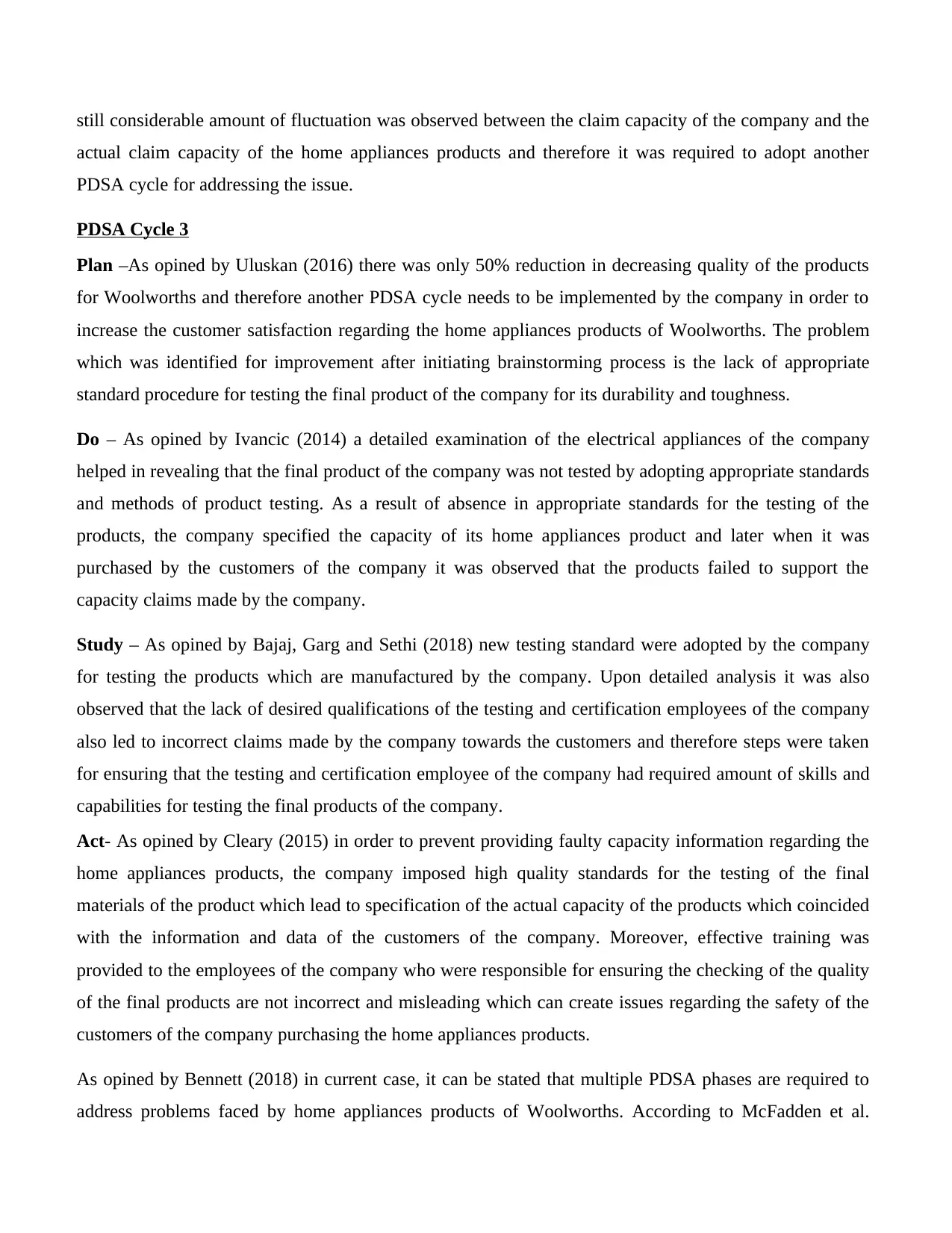
still considerable amount of fluctuation was observed between the claim capacity of the company and the
actual claim capacity of the home appliances products and therefore it was required to adopt another
PDSA cycle for addressing the issue.
PDSA Cycle 3
Plan –As opined by Uluskan (2016) there was only 50% reduction in decreasing quality of the products
for Woolworths and therefore another PDSA cycle needs to be implemented by the company in order to
increase the customer satisfaction regarding the home appliances products of Woolworths. The problem
which was identified for improvement after initiating brainstorming process is the lack of appropriate
standard procedure for testing the final product of the company for its durability and toughness.
Do – As opined by Ivancic (2014) a detailed examination of the electrical appliances of the company
helped in revealing that the final product of the company was not tested by adopting appropriate standards
and methods of product testing. As a result of absence in appropriate standards for the testing of the
products, the company specified the capacity of its home appliances product and later when it was
purchased by the customers of the company it was observed that the products failed to support the
capacity claims made by the company.
Study – As opined by Bajaj, Garg and Sethi (2018) new testing standard were adopted by the company
for testing the products which are manufactured by the company. Upon detailed analysis it was also
observed that the lack of desired qualifications of the testing and certification employees of the company
also led to incorrect claims made by the company towards the customers and therefore steps were taken
for ensuring that the testing and certification employee of the company had required amount of skills and
capabilities for testing the final products of the company.
Act- As opined by Cleary (2015) in order to prevent providing faulty capacity information regarding the
home appliances products, the company imposed high quality standards for the testing of the final
materials of the product which lead to specification of the actual capacity of the products which coincided
with the information and data of the customers of the company. Moreover, effective training was
provided to the employees of the company who were responsible for ensuring the checking of the quality
of the final products are not incorrect and misleading which can create issues regarding the safety of the
customers of the company purchasing the home appliances products.
As opined by Bennett (2018) in current case, it can be stated that multiple PDSA phases are required to
address problems faced by home appliances products of Woolworths. According to McFadden et al.
actual claim capacity of the home appliances products and therefore it was required to adopt another
PDSA cycle for addressing the issue.
PDSA Cycle 3
Plan –As opined by Uluskan (2016) there was only 50% reduction in decreasing quality of the products
for Woolworths and therefore another PDSA cycle needs to be implemented by the company in order to
increase the customer satisfaction regarding the home appliances products of Woolworths. The problem
which was identified for improvement after initiating brainstorming process is the lack of appropriate
standard procedure for testing the final product of the company for its durability and toughness.
Do – As opined by Ivancic (2014) a detailed examination of the electrical appliances of the company
helped in revealing that the final product of the company was not tested by adopting appropriate standards
and methods of product testing. As a result of absence in appropriate standards for the testing of the
products, the company specified the capacity of its home appliances product and later when it was
purchased by the customers of the company it was observed that the products failed to support the
capacity claims made by the company.
Study – As opined by Bajaj, Garg and Sethi (2018) new testing standard were adopted by the company
for testing the products which are manufactured by the company. Upon detailed analysis it was also
observed that the lack of desired qualifications of the testing and certification employees of the company
also led to incorrect claims made by the company towards the customers and therefore steps were taken
for ensuring that the testing and certification employee of the company had required amount of skills and
capabilities for testing the final products of the company.
Act- As opined by Cleary (2015) in order to prevent providing faulty capacity information regarding the
home appliances products, the company imposed high quality standards for the testing of the final
materials of the product which lead to specification of the actual capacity of the products which coincided
with the information and data of the customers of the company. Moreover, effective training was
provided to the employees of the company who were responsible for ensuring the checking of the quality
of the final products are not incorrect and misleading which can create issues regarding the safety of the
customers of the company purchasing the home appliances products.
As opined by Bennett (2018) in current case, it can be stated that multiple PDSA phases are required to
address problems faced by home appliances products of Woolworths. According to McFadden et al.
Paraphrase This Document
Need a fresh take? Get an instant paraphrase of this document with our AI Paraphraser
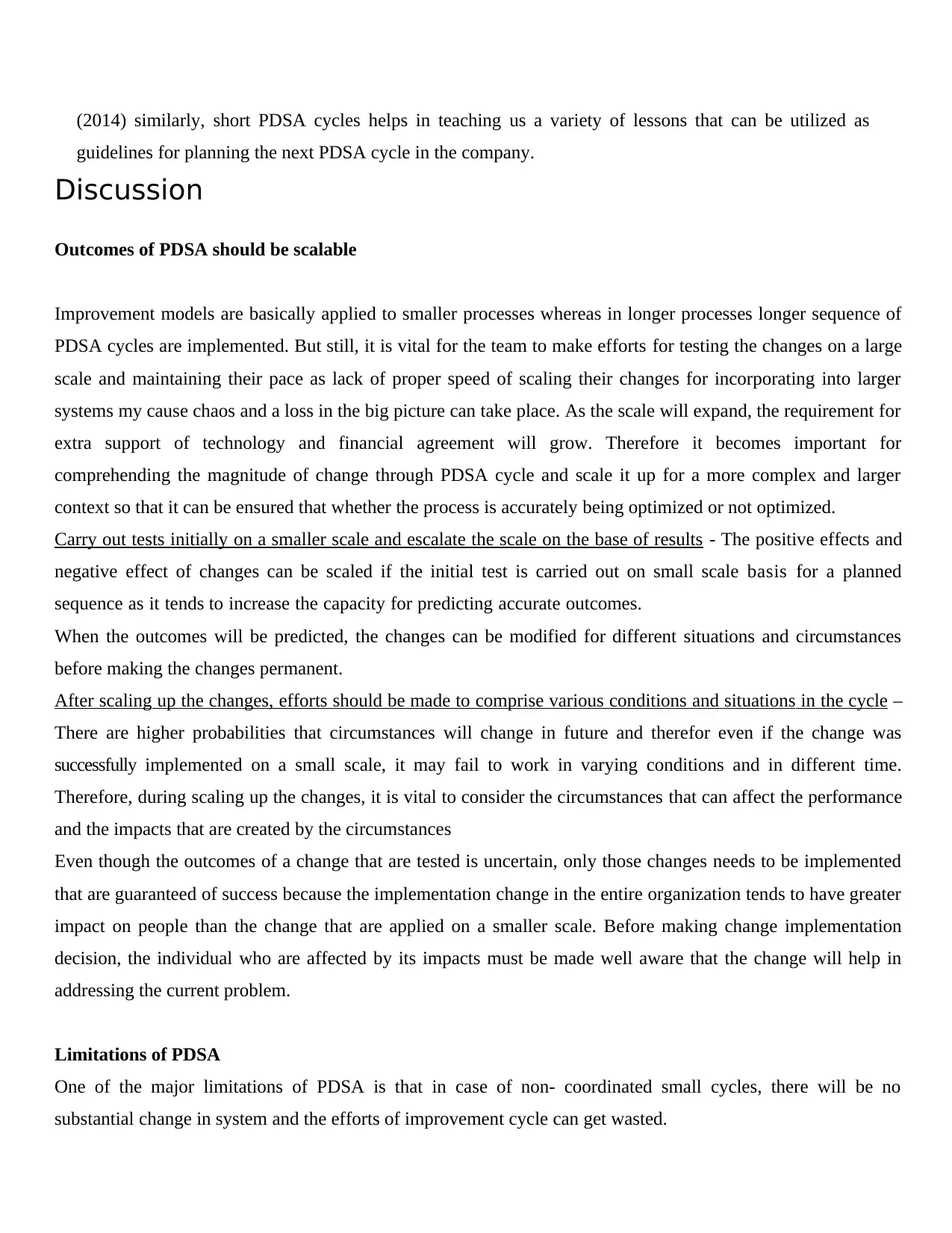
(2014) similarly, short PDSA cycles helps in teaching us a variety of lessons that can be utilized as
guidelines for planning the next PDSA cycle in the company.
Discussion
Outcomes of PDSA should be scalable
Improvement models are basically applied to smaller processes whereas in longer processes longer sequence of
PDSA cycles are implemented. But still, it is vital for the team to make efforts for testing the changes on a large
scale and maintaining their pace as lack of proper speed of scaling their changes for incorporating into larger
systems my cause chaos and a loss in the big picture can take place. As the scale will expand, the requirement for
extra support of technology and financial agreement will grow. Therefore it becomes important for
comprehending the magnitude of change through PDSA cycle and scale it up for a more complex and larger
context so that it can be ensured that whether the process is accurately being optimized or not optimized.
Carry out tests initially on a smaller scale and escalate the scale on the base of results - The positive effects and
negative effect of changes can be scaled if the initial test is carried out on small scale basis for a planned
sequence as it tends to increase the capacity for predicting accurate outcomes.
When the outcomes will be predicted, the changes can be modified for different situations and circumstances
before making the changes permanent.
After scaling up the changes, efforts should be made to comprise various conditions and situations in the cycle –
There are higher probabilities that circumstances will change in future and therefor even if the change was
successfully implemented on a small scale, it may fail to work in varying conditions and in different time.
Therefore, during scaling up the changes, it is vital to consider the circumstances that can affect the performance
and the impacts that are created by the circumstances
Even though the outcomes of a change that are tested is uncertain, only those changes needs to be implemented
that are guaranteed of success because the implementation change in the entire organization tends to have greater
impact on people than the change that are applied on a smaller scale. Before making change implementation
decision, the individual who are affected by its impacts must be made well aware that the change will help in
addressing the current problem.
Limitations of PDSA
One of the major limitations of PDSA is that in case of non- coordinated small cycles, there will be no
substantial change in system and the efforts of improvement cycle can get wasted.
guidelines for planning the next PDSA cycle in the company.
Discussion
Outcomes of PDSA should be scalable
Improvement models are basically applied to smaller processes whereas in longer processes longer sequence of
PDSA cycles are implemented. But still, it is vital for the team to make efforts for testing the changes on a large
scale and maintaining their pace as lack of proper speed of scaling their changes for incorporating into larger
systems my cause chaos and a loss in the big picture can take place. As the scale will expand, the requirement for
extra support of technology and financial agreement will grow. Therefore it becomes important for
comprehending the magnitude of change through PDSA cycle and scale it up for a more complex and larger
context so that it can be ensured that whether the process is accurately being optimized or not optimized.
Carry out tests initially on a smaller scale and escalate the scale on the base of results - The positive effects and
negative effect of changes can be scaled if the initial test is carried out on small scale basis for a planned
sequence as it tends to increase the capacity for predicting accurate outcomes.
When the outcomes will be predicted, the changes can be modified for different situations and circumstances
before making the changes permanent.
After scaling up the changes, efforts should be made to comprise various conditions and situations in the cycle –
There are higher probabilities that circumstances will change in future and therefor even if the change was
successfully implemented on a small scale, it may fail to work in varying conditions and in different time.
Therefore, during scaling up the changes, it is vital to consider the circumstances that can affect the performance
and the impacts that are created by the circumstances
Even though the outcomes of a change that are tested is uncertain, only those changes needs to be implemented
that are guaranteed of success because the implementation change in the entire organization tends to have greater
impact on people than the change that are applied on a smaller scale. Before making change implementation
decision, the individual who are affected by its impacts must be made well aware that the change will help in
addressing the current problem.
Limitations of PDSA
One of the major limitations of PDSA is that in case of non- coordinated small cycles, there will be no
substantial change in system and the efforts of improvement cycle can get wasted.

Moreover, it depends majorly on the trial and error method that implies that the changes needs to be modified
until they are aligned and the intended outcomes are obtained. PDSA cycle can have considerable return on
investment but the efforts, support and resources required are not estimated properly that includes
methodological expertise, funding, buy-in and technological innovation. Lack of adequate finance can lead to the
failure of many projects whereas lack of adequate human resource support can act as hurdles to the change
process as the PDSA cycle required individuals who are trained regarding solving problems.
Conclusion
Thus it can be stated that PDSA is one of the most effective tool that can be used for identifying problems or
improvement opportunities and accordingly develop actions and strategies for addressing and for utilizing
improvement. Also to ensure success of PDSA process, proposed changes must be implemented at first on
an experimental and short term basis and also to ensure that change does not impacts the process and
organization negatively.
until they are aligned and the intended outcomes are obtained. PDSA cycle can have considerable return on
investment but the efforts, support and resources required are not estimated properly that includes
methodological expertise, funding, buy-in and technological innovation. Lack of adequate finance can lead to the
failure of many projects whereas lack of adequate human resource support can act as hurdles to the change
process as the PDSA cycle required individuals who are trained regarding solving problems.
Conclusion
Thus it can be stated that PDSA is one of the most effective tool that can be used for identifying problems or
improvement opportunities and accordingly develop actions and strategies for addressing and for utilizing
improvement. Also to ensure success of PDSA process, proposed changes must be implemented at first on
an experimental and short term basis and also to ensure that change does not impacts the process and
organization negatively.
⊘ This is a preview!⊘
Do you want full access?
Subscribe today to unlock all pages.

Trusted by 1+ million students worldwide
1 out of 16
Related Documents
Your All-in-One AI-Powered Toolkit for Academic Success.
+13062052269
info@desklib.com
Available 24*7 on WhatsApp / Email
![[object Object]](/_next/static/media/star-bottom.7253800d.svg)
Unlock your academic potential
Copyright © 2020–2025 A2Z Services. All Rights Reserved. Developed and managed by ZUCOL.





